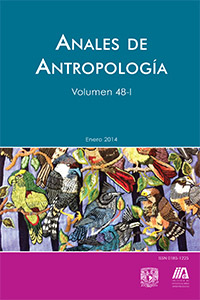Prehispanic foodways: the origins of a tradition in the Basin of Mexico
Main Article Content
Abstract
Alimentation, or the provision of nourishment by food consumption, is a fundamental part of human subsistence, broadly defined as the group of resources required by human beings in order to guarantee satisfaction of their biological necessities. Alimentation is considered to be traditional when it incorporates and maintains cultural foodways that are transmitted from generation to generation (particular ways of preparing and consuming foods), although new components may be introduced through time adding variety. Plants used as foods by prehistoric populations may be studied by analyzing the botanical remains recovered from sediments in archaeological excavations. Two kinds of materials are predominant: macroscopic (seeds, wood and fruits) and microscopic remains (pollen, phytoliths and starch grains). In this paper we present hypotheses concerning the use of plant as foods in the prehispanic Basin of Mexico by comparing the descriptive information provided in Sixteenth Century documents with archaeological data. A group of plants recurrent in domestic contexts during the major periods of settlement was selected, including the Postclassic (Otumba, Xaltocan, Tlatelolco and Iztapalapa), Epiclassic (Michpilco and Xico), Classic (Tetitla, Yayahuala and Oztoyahualco) and Formative (Terremote-Tlatenco, Cuanalan and Temamatla). The continual presence of these plants suggests the development of a tradition through time in the region.
Downloads
Article Details
Citas en Dimensions Service
Esta revista usa una licencia CC del tipo CC BY-NC-ND 3.0. Se maneja bajo el esquema de acceso abierto, con una licencia Creative Commons Attribution-NonCommercial-NoDerivs 3.0 Unported.
